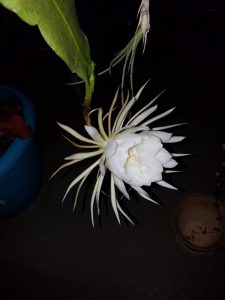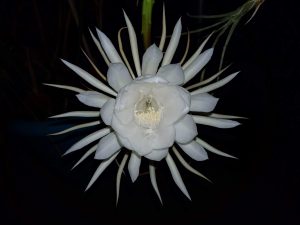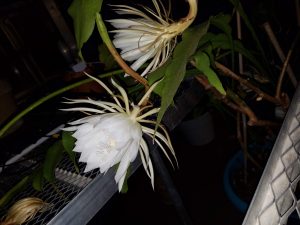Most of the year The Queen of the Night, an orchid cactus in the genus epiphyllum, is a strange-looking cluster of “leaves” (which are actually just modified stems). It is called an “orchid” cactus because just like most orchids it is epiphytic (growing on other plants, like trees) or lithophytic (growing on rocks). Did you know that cacti grow all over the place, and not just in the desert? The Queen of the Night is native to moist forests and even the jungles of South and Central America! (llifle.com)
The Queen is cultivated around the world and is incredibly popular, but what makes this cactus so special?
The Queen of the Night is a night-blooming cactus which blooms once per year, reaching full bloom around midnight.
Why does this strange plant behave this way?
This behavior is what’s called a pollination syndrome. A pollination syndrome occurs when a plant co-evolves with its primary pollinators in a way that increases the likelihood of successful pollination (USDA/USFS 2006). The Queen of the Night’s main pollinators are bats, and for this reason, it makes sense that The Queen would only bloom at night, when its pollinators are active. The large, white, disc-shaped flowers are known to be more attractive to bats as well (USDA/USFS 2006). Interestingly, multiple individuals all bloom on the same night of each year. It is not known how this occurs (Tohono Chul, 2012).




Bibliography
Tohono Chul. 2012. Bloom Night. May 22. Accessed February 12, 2020. https://tohonochul.org/bloom-watch/.
USDA/USFS. 2006. Pollinator Syndromes. July 16. Accessed February 12, 2020. https://www.fs.fed.us/wildflowers/pollinators/What_is_Pollination/syndromes.shtml.
“Epiphyllum oxypetalum” Text available under a CC-BY-SA Creative Commons Attribution License. www.llifle.com 14 Nov. 2005. 25 Feb 2020. </Encyclopedia/CACTI/Family/Cactaceae/8223/Epiphyllum_oxypetalum>